HI6005 - Analyzing Culture & Structure in Global Organizations
VerifiedAdded on 2023/06/12
|7
|1545
|131
Essay
AI Summary
This essay provides an analysis of organizational culture and structure within a global environment, drawing upon lectures that define organizational culture, its dimensions, determinants, and types, as well as the attributes of organizational structure and design. It examines the changes in IBM's organizational culture, the role of leadership, and the shift towards a more organic structure. The essay highlights the importance of adapting organizational designs to foster a strong organizational culture characterized by teamwork, innovation, and customer service. It concludes that a dynamic environment, effective leadership, and information sharing are crucial for developing a robust organizational culture, as demonstrated by IBM's transformation.
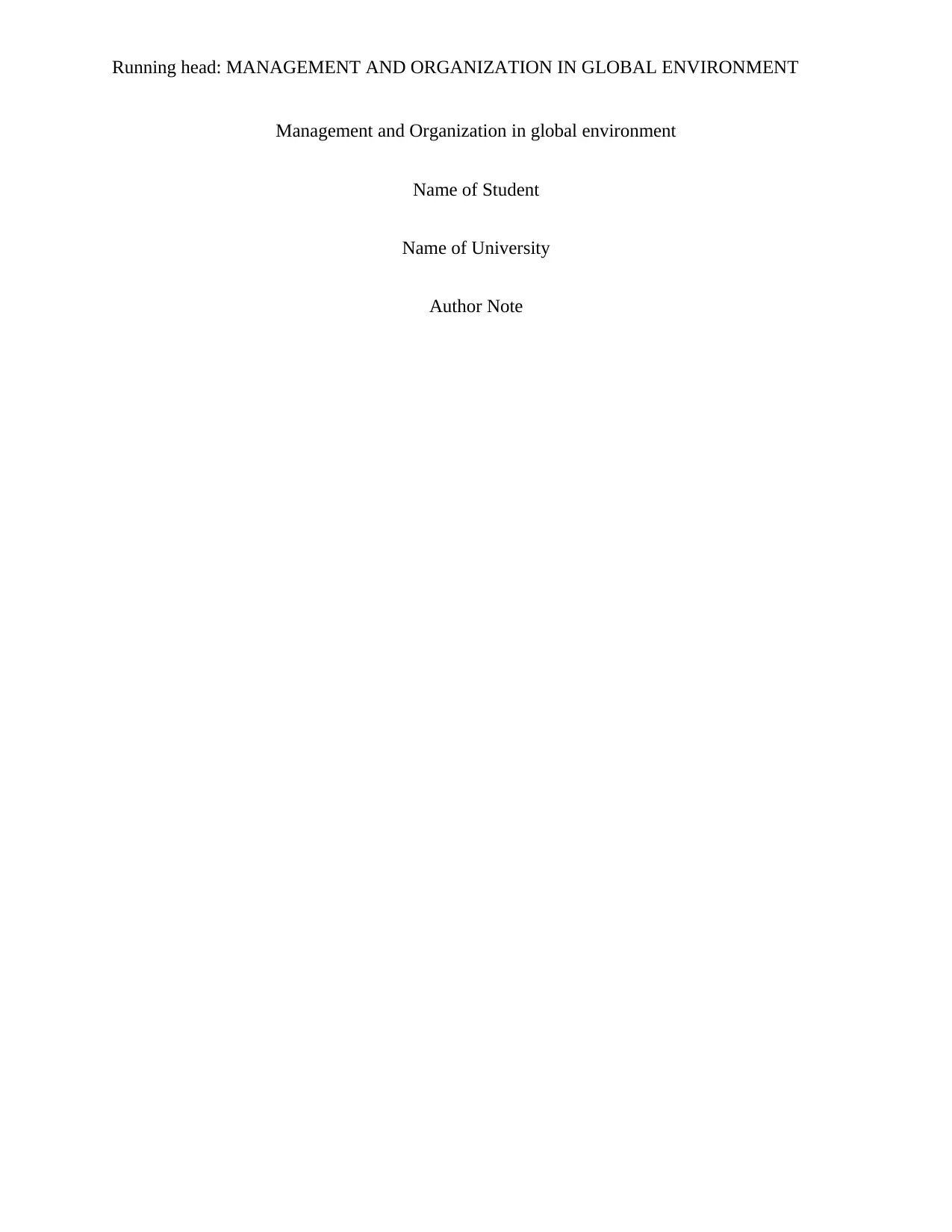
Running head: MANAGEMENT AND ORGANIZATION IN GLOBAL ENVIRONMENT
Management and Organization in global environment
Name of Student
Name of University
Author Note
Management and Organization in global environment
Name of Student
Name of University
Author Note
Paraphrase This Document
Need a fresh take? Get an instant paraphrase of this document with our AI Paraphraser
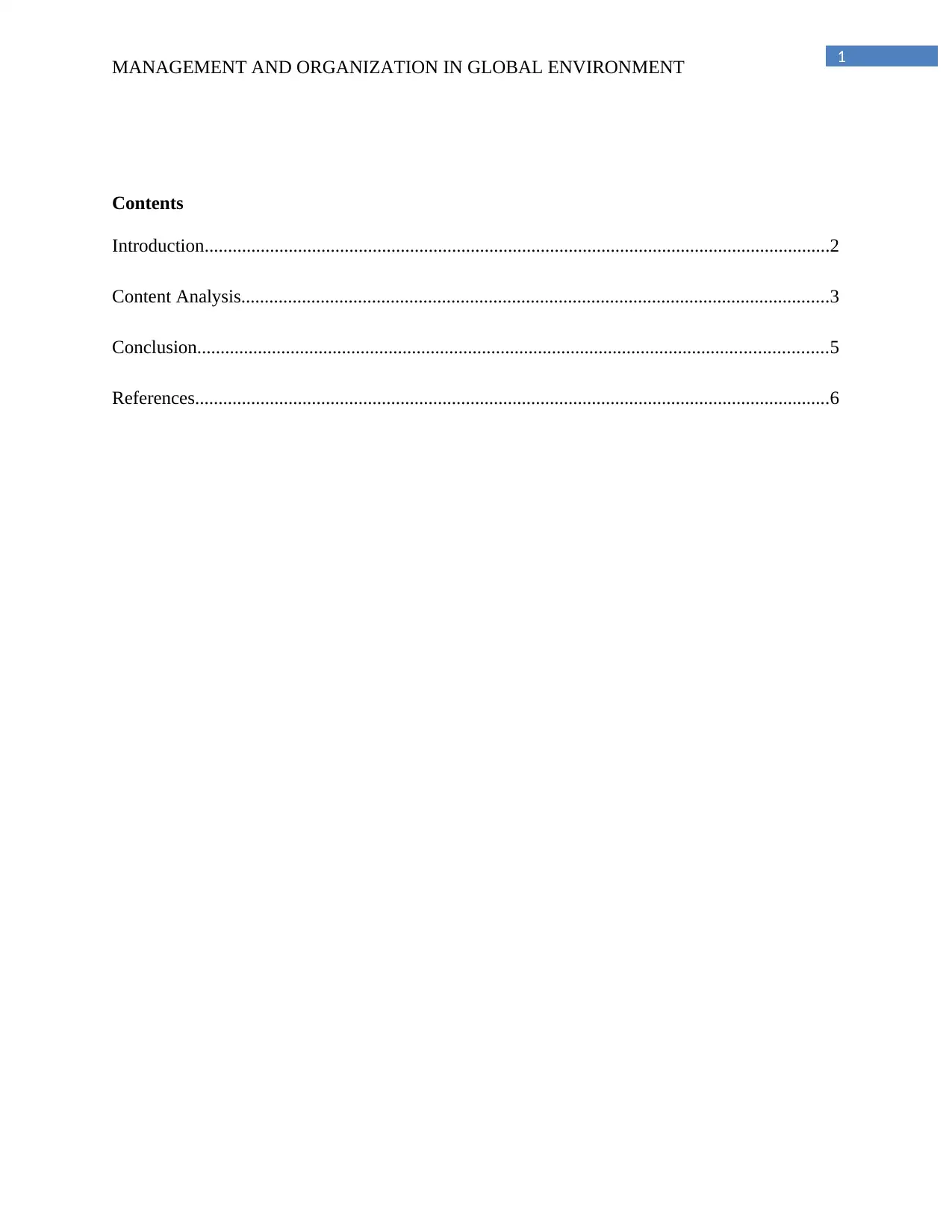
1
MANAGEMENT AND ORGANIZATION IN GLOBAL ENVIRONMENT
Contents
Introduction......................................................................................................................................2
Content Analysis..............................................................................................................................3
Conclusion.......................................................................................................................................5
References........................................................................................................................................6
MANAGEMENT AND ORGANIZATION IN GLOBAL ENVIRONMENT
Contents
Introduction......................................................................................................................................2
Content Analysis..............................................................................................................................3
Conclusion.......................................................................................................................................5
References........................................................................................................................................6
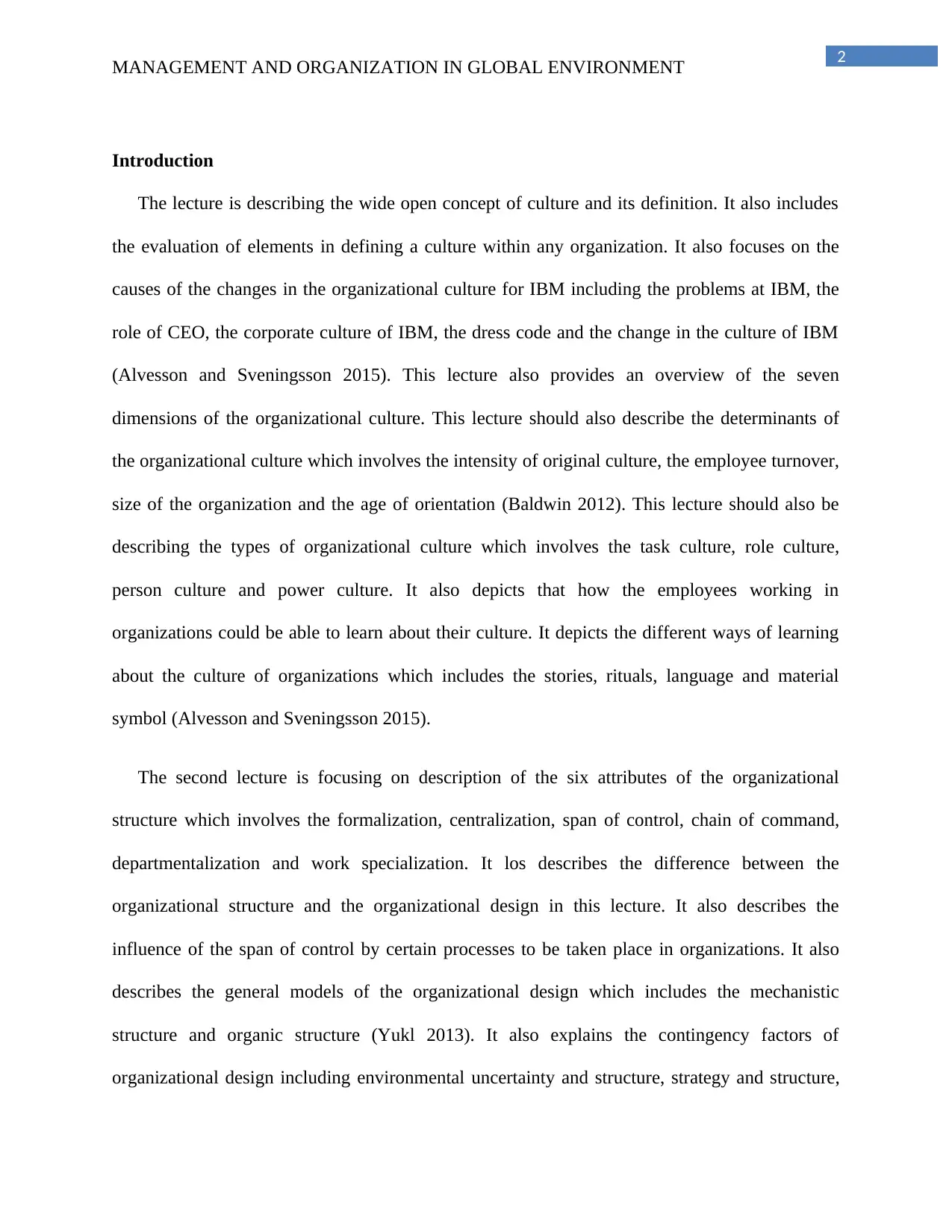
2
MANAGEMENT AND ORGANIZATION IN GLOBAL ENVIRONMENT
Introduction
The lecture is describing the wide open concept of culture and its definition. It also includes
the evaluation of elements in defining a culture within any organization. It also focuses on the
causes of the changes in the organizational culture for IBM including the problems at IBM, the
role of CEO, the corporate culture of IBM, the dress code and the change in the culture of IBM
(Alvesson and Sveningsson 2015). This lecture also provides an overview of the seven
dimensions of the organizational culture. This lecture should also describe the determinants of
the organizational culture which involves the intensity of original culture, the employee turnover,
size of the organization and the age of orientation (Baldwin 2012). This lecture should also be
describing the types of organizational culture which involves the task culture, role culture,
person culture and power culture. It also depicts that how the employees working in
organizations could be able to learn about their culture. It depicts the different ways of learning
about the culture of organizations which includes the stories, rituals, language and material
symbol (Alvesson and Sveningsson 2015).
The second lecture is focusing on description of the six attributes of the organizational
structure which involves the formalization, centralization, span of control, chain of command,
departmentalization and work specialization. It los describes the difference between the
organizational structure and the organizational design in this lecture. It also describes the
influence of the span of control by certain processes to be taken place in organizations. It also
describes the general models of the organizational design which includes the mechanistic
structure and organic structure (Yukl 2013). It also explains the contingency factors of
organizational design including environmental uncertainty and structure, strategy and structure,
MANAGEMENT AND ORGANIZATION IN GLOBAL ENVIRONMENT
Introduction
The lecture is describing the wide open concept of culture and its definition. It also includes
the evaluation of elements in defining a culture within any organization. It also focuses on the
causes of the changes in the organizational culture for IBM including the problems at IBM, the
role of CEO, the corporate culture of IBM, the dress code and the change in the culture of IBM
(Alvesson and Sveningsson 2015). This lecture also provides an overview of the seven
dimensions of the organizational culture. This lecture should also describe the determinants of
the organizational culture which involves the intensity of original culture, the employee turnover,
size of the organization and the age of orientation (Baldwin 2012). This lecture should also be
describing the types of organizational culture which involves the task culture, role culture,
person culture and power culture. It also depicts that how the employees working in
organizations could be able to learn about their culture. It depicts the different ways of learning
about the culture of organizations which includes the stories, rituals, language and material
symbol (Alvesson and Sveningsson 2015).
The second lecture is focusing on description of the six attributes of the organizational
structure which involves the formalization, centralization, span of control, chain of command,
departmentalization and work specialization. It los describes the difference between the
organizational structure and the organizational design in this lecture. It also describes the
influence of the span of control by certain processes to be taken place in organizations. It also
describes the general models of the organizational design which includes the mechanistic
structure and organic structure (Yukl 2013). It also explains the contingency factors of
organizational design including environmental uncertainty and structure, strategy and structure,
⊘ This is a preview!⊘
Do you want full access?
Subscribe today to unlock all pages.

Trusted by 1+ million students worldwide
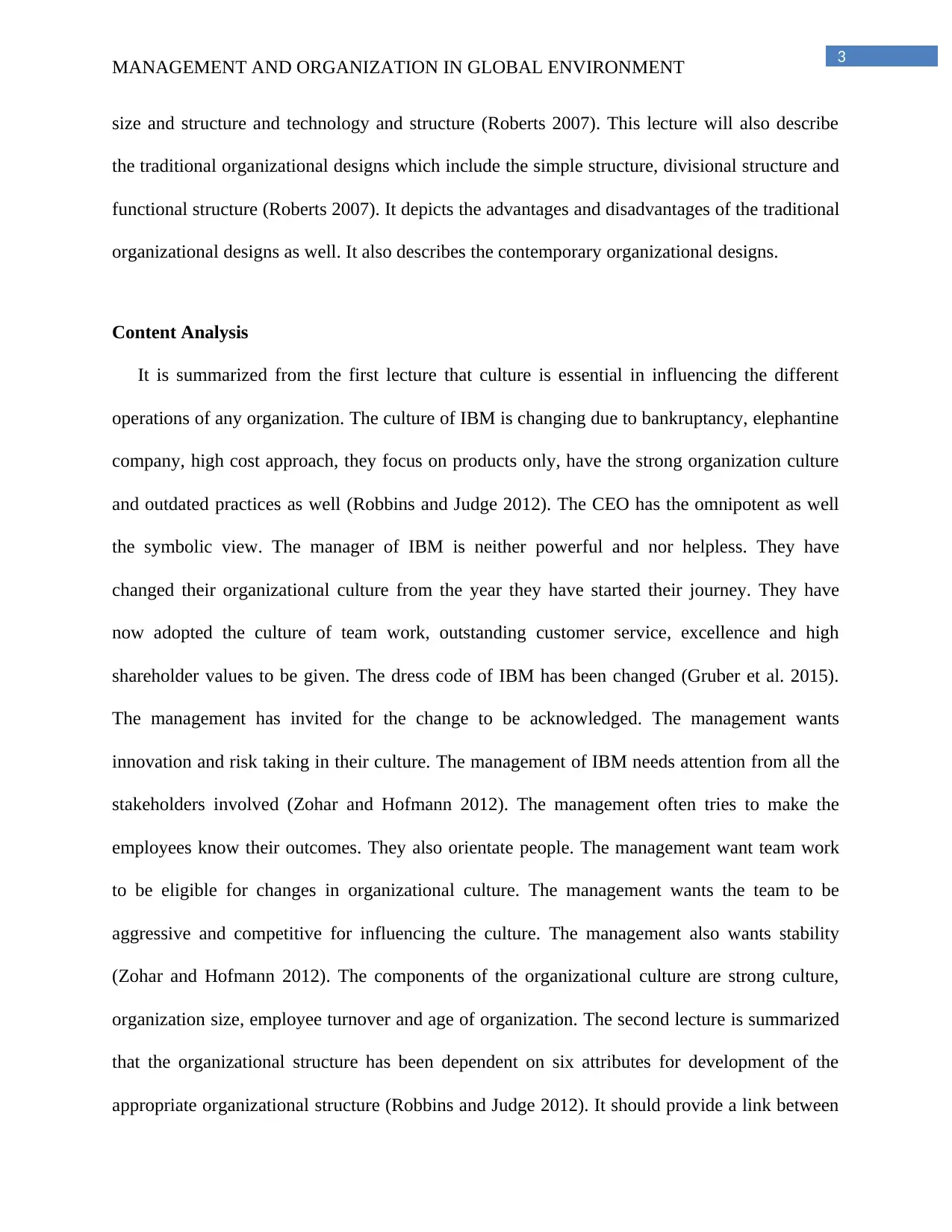
3
MANAGEMENT AND ORGANIZATION IN GLOBAL ENVIRONMENT
size and structure and technology and structure (Roberts 2007). This lecture will also describe
the traditional organizational designs which include the simple structure, divisional structure and
functional structure (Roberts 2007). It depicts the advantages and disadvantages of the traditional
organizational designs as well. It also describes the contemporary organizational designs.
Content Analysis
It is summarized from the first lecture that culture is essential in influencing the different
operations of any organization. The culture of IBM is changing due to bankruptancy, elephantine
company, high cost approach, they focus on products only, have the strong organization culture
and outdated practices as well (Robbins and Judge 2012). The CEO has the omnipotent as well
the symbolic view. The manager of IBM is neither powerful and nor helpless. They have
changed their organizational culture from the year they have started their journey. They have
now adopted the culture of team work, outstanding customer service, excellence and high
shareholder values to be given. The dress code of IBM has been changed (Gruber et al. 2015).
The management has invited for the change to be acknowledged. The management wants
innovation and risk taking in their culture. The management of IBM needs attention from all the
stakeholders involved (Zohar and Hofmann 2012). The management often tries to make the
employees know their outcomes. They also orientate people. The management want team work
to be eligible for changes in organizational culture. The management wants the team to be
aggressive and competitive for influencing the culture. The management also wants stability
(Zohar and Hofmann 2012). The components of the organizational culture are strong culture,
organization size, employee turnover and age of organization. The second lecture is summarized
that the organizational structure has been dependent on six attributes for development of the
appropriate organizational structure (Robbins and Judge 2012). It should provide a link between
MANAGEMENT AND ORGANIZATION IN GLOBAL ENVIRONMENT
size and structure and technology and structure (Roberts 2007). This lecture will also describe
the traditional organizational designs which include the simple structure, divisional structure and
functional structure (Roberts 2007). It depicts the advantages and disadvantages of the traditional
organizational designs as well. It also describes the contemporary organizational designs.
Content Analysis
It is summarized from the first lecture that culture is essential in influencing the different
operations of any organization. The culture of IBM is changing due to bankruptancy, elephantine
company, high cost approach, they focus on products only, have the strong organization culture
and outdated practices as well (Robbins and Judge 2012). The CEO has the omnipotent as well
the symbolic view. The manager of IBM is neither powerful and nor helpless. They have
changed their organizational culture from the year they have started their journey. They have
now adopted the culture of team work, outstanding customer service, excellence and high
shareholder values to be given. The dress code of IBM has been changed (Gruber et al. 2015).
The management has invited for the change to be acknowledged. The management wants
innovation and risk taking in their culture. The management of IBM needs attention from all the
stakeholders involved (Zohar and Hofmann 2012). The management often tries to make the
employees know their outcomes. They also orientate people. The management want team work
to be eligible for changes in organizational culture. The management wants the team to be
aggressive and competitive for influencing the culture. The management also wants stability
(Zohar and Hofmann 2012). The components of the organizational culture are strong culture,
organization size, employee turnover and age of organization. The second lecture is summarized
that the organizational structure has been dependent on six attributes for development of the
appropriate organizational structure (Robbins and Judge 2012). It should provide a link between
Paraphrase This Document
Need a fresh take? Get an instant paraphrase of this document with our AI Paraphraser
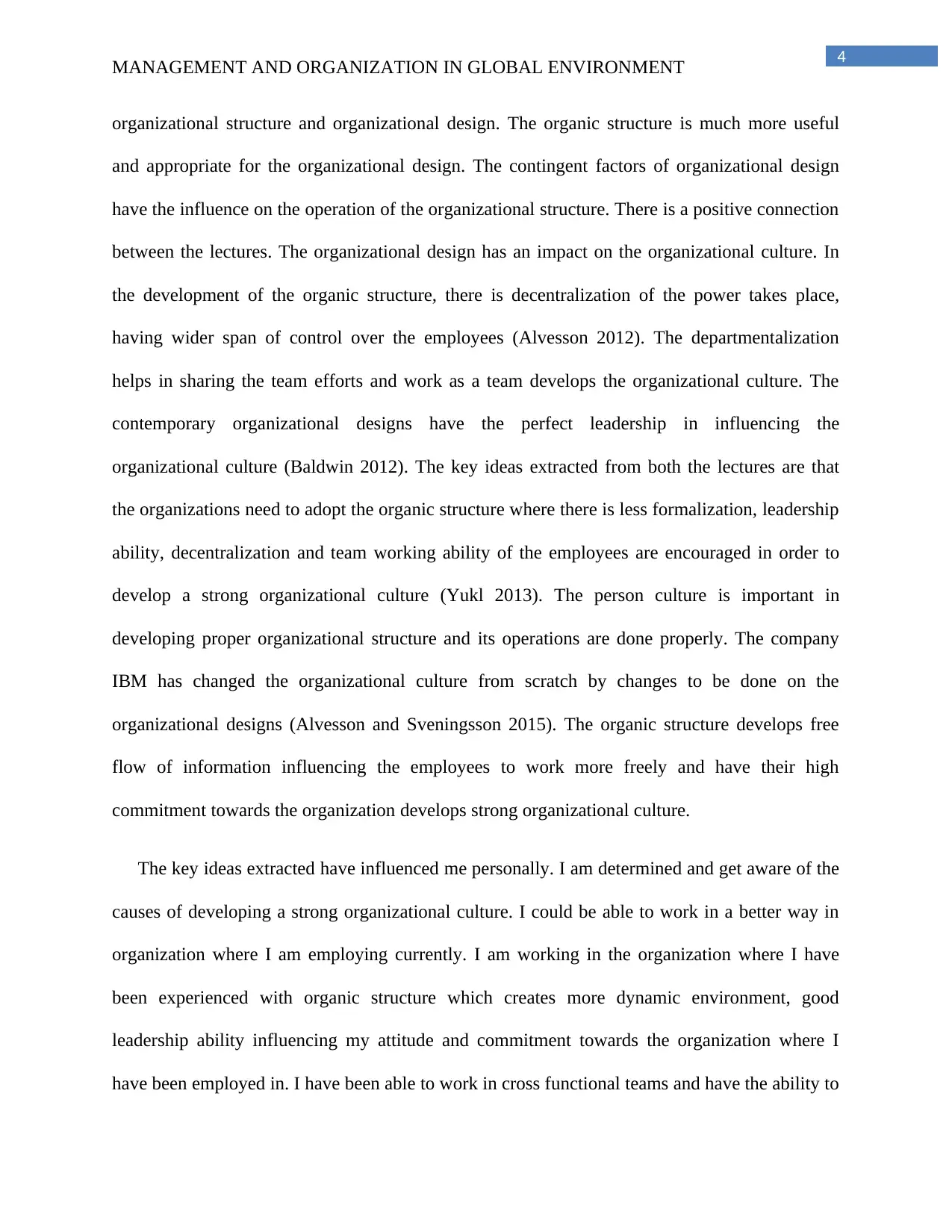
4
MANAGEMENT AND ORGANIZATION IN GLOBAL ENVIRONMENT
organizational structure and organizational design. The organic structure is much more useful
and appropriate for the organizational design. The contingent factors of organizational design
have the influence on the operation of the organizational structure. There is a positive connection
between the lectures. The organizational design has an impact on the organizational culture. In
the development of the organic structure, there is decentralization of the power takes place,
having wider span of control over the employees (Alvesson 2012). The departmentalization
helps in sharing the team efforts and work as a team develops the organizational culture. The
contemporary organizational designs have the perfect leadership in influencing the
organizational culture (Baldwin 2012). The key ideas extracted from both the lectures are that
the organizations need to adopt the organic structure where there is less formalization, leadership
ability, decentralization and team working ability of the employees are encouraged in order to
develop a strong organizational culture (Yukl 2013). The person culture is important in
developing proper organizational structure and its operations are done properly. The company
IBM has changed the organizational culture from scratch by changes to be done on the
organizational designs (Alvesson and Sveningsson 2015). The organic structure develops free
flow of information influencing the employees to work more freely and have their high
commitment towards the organization develops strong organizational culture.
The key ideas extracted have influenced me personally. I am determined and get aware of the
causes of developing a strong organizational culture. I could be able to work in a better way in
organization where I am employing currently. I am working in the organization where I have
been experienced with organic structure which creates more dynamic environment, good
leadership ability influencing my attitude and commitment towards the organization where I
have been employed in. I have been able to work in cross functional teams and have the ability to
MANAGEMENT AND ORGANIZATION IN GLOBAL ENVIRONMENT
organizational structure and organizational design. The organic structure is much more useful
and appropriate for the organizational design. The contingent factors of organizational design
have the influence on the operation of the organizational structure. There is a positive connection
between the lectures. The organizational design has an impact on the organizational culture. In
the development of the organic structure, there is decentralization of the power takes place,
having wider span of control over the employees (Alvesson 2012). The departmentalization
helps in sharing the team efforts and work as a team develops the organizational culture. The
contemporary organizational designs have the perfect leadership in influencing the
organizational culture (Baldwin 2012). The key ideas extracted from both the lectures are that
the organizations need to adopt the organic structure where there is less formalization, leadership
ability, decentralization and team working ability of the employees are encouraged in order to
develop a strong organizational culture (Yukl 2013). The person culture is important in
developing proper organizational structure and its operations are done properly. The company
IBM has changed the organizational culture from scratch by changes to be done on the
organizational designs (Alvesson and Sveningsson 2015). The organic structure develops free
flow of information influencing the employees to work more freely and have their high
commitment towards the organization develops strong organizational culture.
The key ideas extracted have influenced me personally. I am determined and get aware of the
causes of developing a strong organizational culture. I could be able to work in a better way in
organization where I am employing currently. I am working in the organization where I have
been experienced with organic structure which creates more dynamic environment, good
leadership ability influencing my attitude and commitment towards the organization where I
have been employed in. I have been able to work in cross functional teams and have the ability to
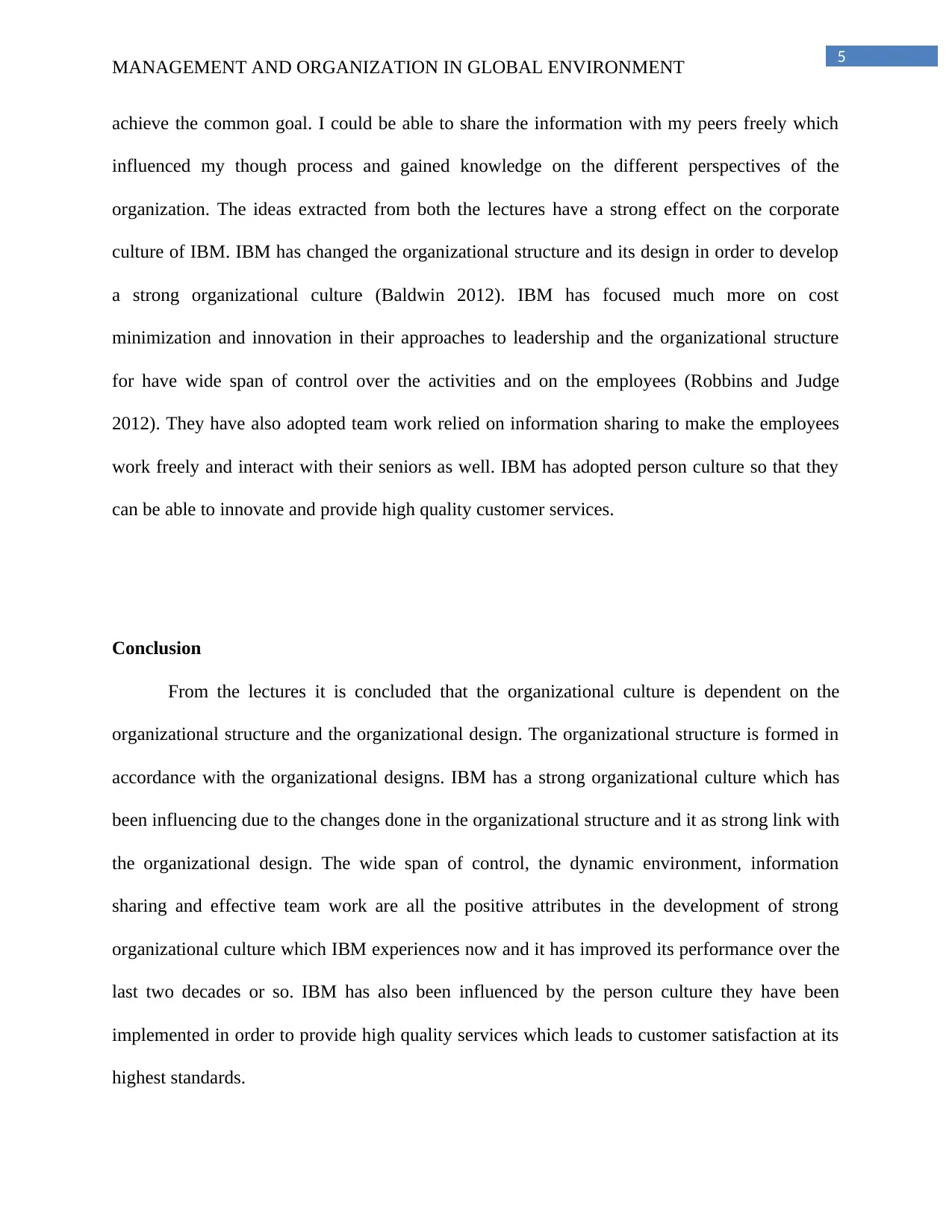
5
MANAGEMENT AND ORGANIZATION IN GLOBAL ENVIRONMENT
achieve the common goal. I could be able to share the information with my peers freely which
influenced my though process and gained knowledge on the different perspectives of the
organization. The ideas extracted from both the lectures have a strong effect on the corporate
culture of IBM. IBM has changed the organizational structure and its design in order to develop
a strong organizational culture (Baldwin 2012). IBM has focused much more on cost
minimization and innovation in their approaches to leadership and the organizational structure
for have wide span of control over the activities and on the employees (Robbins and Judge
2012). They have also adopted team work relied on information sharing to make the employees
work freely and interact with their seniors as well. IBM has adopted person culture so that they
can be able to innovate and provide high quality customer services.
Conclusion
From the lectures it is concluded that the organizational culture is dependent on the
organizational structure and the organizational design. The organizational structure is formed in
accordance with the organizational designs. IBM has a strong organizational culture which has
been influencing due to the changes done in the organizational structure and it as strong link with
the organizational design. The wide span of control, the dynamic environment, information
sharing and effective team work are all the positive attributes in the development of strong
organizational culture which IBM experiences now and it has improved its performance over the
last two decades or so. IBM has also been influenced by the person culture they have been
implemented in order to provide high quality services which leads to customer satisfaction at its
highest standards.
MANAGEMENT AND ORGANIZATION IN GLOBAL ENVIRONMENT
achieve the common goal. I could be able to share the information with my peers freely which
influenced my though process and gained knowledge on the different perspectives of the
organization. The ideas extracted from both the lectures have a strong effect on the corporate
culture of IBM. IBM has changed the organizational structure and its design in order to develop
a strong organizational culture (Baldwin 2012). IBM has focused much more on cost
minimization and innovation in their approaches to leadership and the organizational structure
for have wide span of control over the activities and on the employees (Robbins and Judge
2012). They have also adopted team work relied on information sharing to make the employees
work freely and interact with their seniors as well. IBM has adopted person culture so that they
can be able to innovate and provide high quality customer services.
Conclusion
From the lectures it is concluded that the organizational culture is dependent on the
organizational structure and the organizational design. The organizational structure is formed in
accordance with the organizational designs. IBM has a strong organizational culture which has
been influencing due to the changes done in the organizational structure and it as strong link with
the organizational design. The wide span of control, the dynamic environment, information
sharing and effective team work are all the positive attributes in the development of strong
organizational culture which IBM experiences now and it has improved its performance over the
last two decades or so. IBM has also been influenced by the person culture they have been
implemented in order to provide high quality services which leads to customer satisfaction at its
highest standards.
⊘ This is a preview!⊘
Do you want full access?
Subscribe today to unlock all pages.

Trusted by 1+ million students worldwide
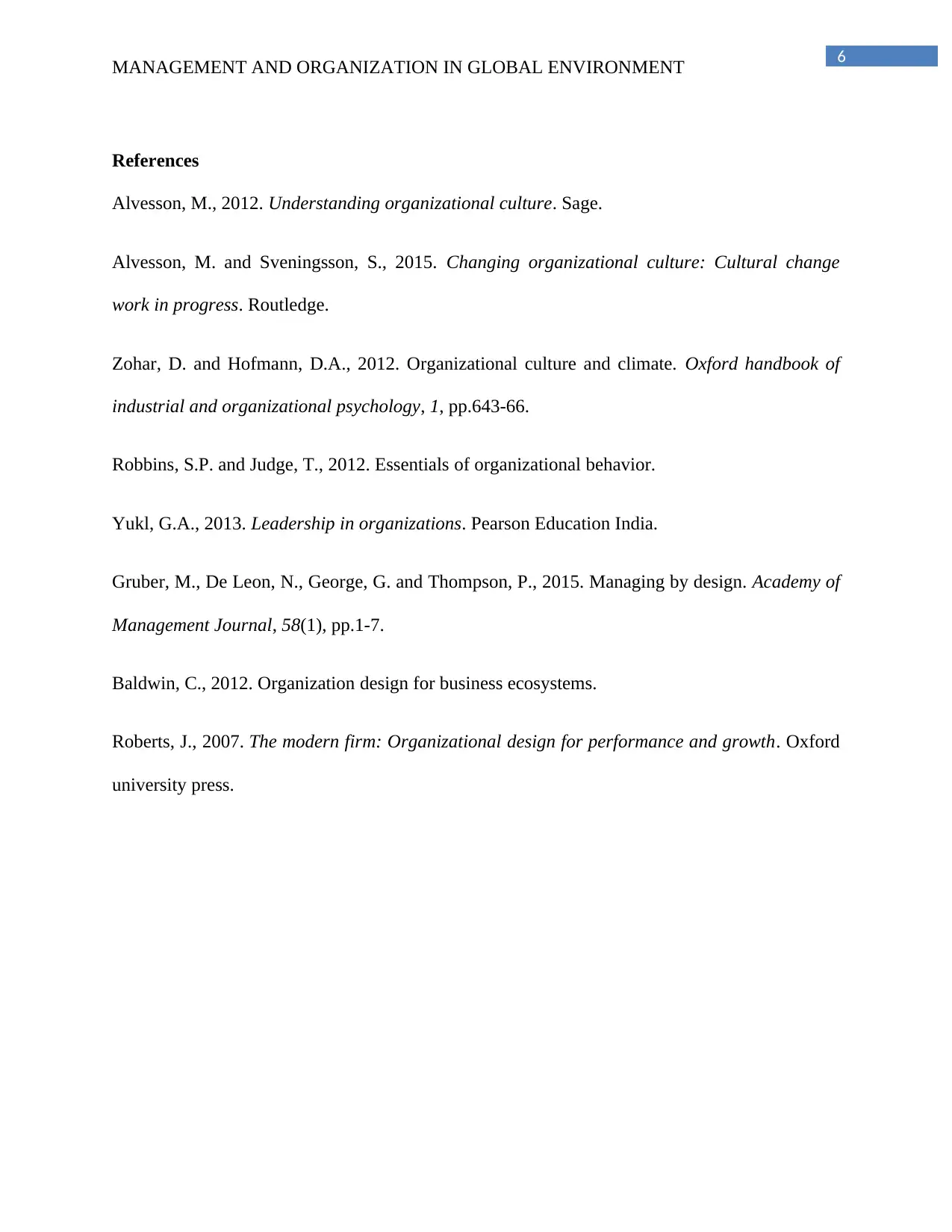
6
MANAGEMENT AND ORGANIZATION IN GLOBAL ENVIRONMENT
References
Alvesson, M., 2012. Understanding organizational culture. Sage.
Alvesson, M. and Sveningsson, S., 2015. Changing organizational culture: Cultural change
work in progress. Routledge.
Zohar, D. and Hofmann, D.A., 2012. Organizational culture and climate. Oxford handbook of
industrial and organizational psychology, 1, pp.643-66.
Robbins, S.P. and Judge, T., 2012. Essentials of organizational behavior.
Yukl, G.A., 2013. Leadership in organizations. Pearson Education India.
Gruber, M., De Leon, N., George, G. and Thompson, P., 2015. Managing by design. Academy of
Management Journal, 58(1), pp.1-7.
Baldwin, C., 2012. Organization design for business ecosystems.
Roberts, J., 2007. The modern firm: Organizational design for performance and growth. Oxford
university press.
MANAGEMENT AND ORGANIZATION IN GLOBAL ENVIRONMENT
References
Alvesson, M., 2012. Understanding organizational culture. Sage.
Alvesson, M. and Sveningsson, S., 2015. Changing organizational culture: Cultural change
work in progress. Routledge.
Zohar, D. and Hofmann, D.A., 2012. Organizational culture and climate. Oxford handbook of
industrial and organizational psychology, 1, pp.643-66.
Robbins, S.P. and Judge, T., 2012. Essentials of organizational behavior.
Yukl, G.A., 2013. Leadership in organizations. Pearson Education India.
Gruber, M., De Leon, N., George, G. and Thompson, P., 2015. Managing by design. Academy of
Management Journal, 58(1), pp.1-7.
Baldwin, C., 2012. Organization design for business ecosystems.
Roberts, J., 2007. The modern firm: Organizational design for performance and growth. Oxford
university press.
1 out of 7
Related Documents
Your All-in-One AI-Powered Toolkit for Academic Success.
+13062052269
info@desklib.com
Available 24*7 on WhatsApp / Email
![[object Object]](/_next/static/media/star-bottom.7253800d.svg)
Unlock your academic potential
Copyright © 2020–2025 A2Z Services. All Rights Reserved. Developed and managed by ZUCOL.




